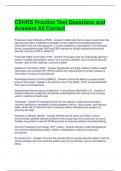CEHRS Practice Test Questions and
Answers All Correct
Physicians Desk Reference (PDR) - Answer-Traditionally this is a large, bound look that
lists all prescription medications available on the market and includes prescribing
information from the manufacturers; it is now available by subscription in an electronic
format, accessible through EHR and EMR systems or though standalone electronic
devices, such as a PDA or tablet PC
Protected Health Information (PHI) - Answer-Information that can individually identify a
person; includes demographic data or any common identifier, such as Social Security
number, date of birth, address, or phone number
Release of Information (ROI) - Answer-Appropriate and legal release of patient health
information that includes PHI; HIPAA outlines the requirements for proper release of
information in various circumstances
Role-Based Access Controls (RBACs) - Answer-Control the ability to access certain
areas of the system, based on the persons role in the facility, which is associated with
their login ID and password
Systematized Nomenclature of Medicine - Clinical terms (SNOMED-CT) - Answer-A
medical reference vocabulary that serves to standardized the naming of terminology
used in medicine & health care
Templates - Answer-Pre-designed forms for the capture of data and information;
common attributes of templates include dropdown menus, check boxes, and required
fields, which will not allow the user to advance without answering the question or
providing the data
Wireless on Wheels (WOW) - Answer-WOWs are the same as COWs; in some
environments, patients may be sensitive to the casual use of the word cow, so some
facilities may prefer to use the WOW acronym to avoid any patient misunderstanding
Current Procedural Terminology (CPT) codes - Answer-Numeric codes developed by
the American Medical Association (AMA) to standardize medical services and
procedures
Encounter form - Answer-The form the provider fills out as she sees the patient; lists the
service charges and how much the patient paid for the services; can be submitted for
billing
, Face sheet - Answer-A standard structure document that contains patient information,
on, such as name, date of birth, insurance information, reason for seeking medical care,
and religious preference; medical staff uses the document to quickly see the relevant
points for patient care
Health Care Common Procedure Coding System (HCPCS) - Answer-A numeric and
alphabetic coding system used for billing and pricing of procedures, medical supplies,
medications, and durable medical equipment
International Classification of Diseases, Ninth Revision, Clinical Modification (ICD-9-
CM) codes - Answer-Alphanumeric codes used to classify injuries, diseases, symptoms,
and cause of death
Insurance verification - Answer-Process used to make sure the service received by the
patient is approved and paid for by the insurance company
National provider identifier (NPI) number - Answer-A unique 10-digit number assigned
to providers in the U.S. to identify themselves in all HIPAA transactions
Practice management systems - Answer-A software designed to assist in the office
workflow by streamlining scheduling, insurance information, patient demographics, and
billing
Third-party vendor - Answer-A separate business that handles a specific task for a
facility; common third-party vendors include billing companies, transcription companies,
and coding firms
Ad hoc reports - Answer-Reports created or programmed in response to an inquiry or
issue that comes up; they are not normally scheduled reports
Compliance - Answer-Compliance as it relates to paper or electronic medical records
refers to the completion of the record and the adherence to medical records and
documentation requirements set forth by state and federal law, as well as accreditation
and regulatory agencies
Affordable Care Act - Answer-Mandates comprehensive health insurance reform; some
of the provisions of this law include prohibiting the denial of coverage based on pre-
existing conditions, preventing insurance companies from rescinding coverage when
someone gets sick, eliminating lifetime limits or caps on insurance coverage, appealing
insurance company decisions, providing free preventive care, getting tough on health
care fraud, and extending the amount of time parents can cover their adult children on
their own insurance policies; many more provisions are in place today and more will roll
outthrough 2014




